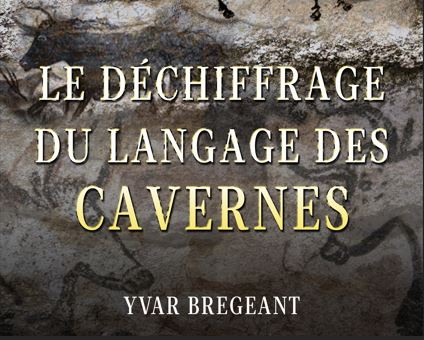PURPOSE OF THIS ARTICLE
This article helps to demonstrate the perfect correspondence between Upper Palaeolithic rock paintings and the proto-Sumerian or proto-Cuneiform ideographic language.
This demonstration is divided into four parts:
The first part (see previous article) compares around a hundred prehistoric signs identified and divided into their 25 categories with identical signs from the proto-Sumerian period. This visual comparison shows that they are extremely similar, and in itself confirms that they are indeed the same writing system.
The second part (which is the subject of this article) presents the results of previous research into this question of prehistoric signs.
The third part (article to follow) shows the errors and mistakes made by previous researchers on this issue, which prevented them from reaching the right conclusion.
The fourth part (article to follow) then provides the full semiological demonstration of the correspondence between the two writing systems, carrying out correctly and exhaustively the comparative background analysis that should have been carried out (comparison of the corpus of signs and semiological rules relating to each system) to arrive at the right result and conclusion: the Upper Palaeolithic rock paintings, with their pairs of images and signs, correspond in every respect to the Sumerian ideographic language and its associated languages (Sumerian, hieroglyphic Egyptian).
Table of contents
LINK THIS ARTICLE TO THE ENTIRE LITERARY SERIES “THE TRUE HISTORY OF MANKIND’S RELIGIONS”
This article is an excerpt from the book also available on this site:
Volume 2 Book 2 Deciphering the language of the caves
You can also find this book here :
Already published books
To find out why this book is part of the literary series The True Stories of Mankind’s Religions, go to page :
Introduction / Structure and Content
I hope you enjoy reading this article, which is available in its entirety below:
Part II: Previous scientific research on this issue and its conclusions
The research of André Leroi-Gourhan
Source :https://www.persee.fr/doc/bspf_0249-7638_1958_num_55_7_3675
Le symbolisme des grands signes dans l’art pariétal paléolithique André Leroi-Gourhan ; Bulletin de la Société préhistorique française Année 1958 55-7-8 pp. 384-398
First of all, here’s a list of the rock art signs recorded by André Leroi Gourhan.
It classifies them into twelve broad categories as follows:
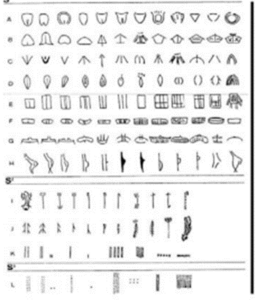
In his article, André Leroi-Gourhan begins by noting that not only do groups of animals (often walking in the same two pairs of species, bison-horse, ox-horse, etc.) and signs form a “figurative whole”, but that signs often walk in pairs. “He deduces that “this relationship of proximity is not fortuitous, as the repetition of characteristic groupings is constant throughout the Franco-Cantabrian domain“.
That’s why he calls signs that work in pairs “coupled signs” and others, less numerous and not working in pairs, “uncoupled” signs.
For André Leroi-Gourhan, paired signs are either “solid” symbols, which he interprets as female, or “thin” symbols, which he interprets as male. According to him, the association of these signs in pairs or couples serves to symbolize sexual union.
Here’s how he classifies them:
First members of the pair
Oval signs
![]()
![]()
![]()
![]()
![]()
![]()
![]()
Triangular signs
![]()
![]()
![]()
Scutiform (shield-shaped) signs
![]()
![]()
![]()
Comb-shaped signs (pettiforme)
![]()
Grid signs
![]()
![]()
Claviform signs (for, according to him, club-shaped)
![]()
![]()
Second members of the pair
Feather or twig signs

![]()
![]()

In strokes
![]()
Lines of dots
![]()
In short hatchings
![]()
![]()
Uncoupled signs
![]()
They appear separately and usually in groups of identical signs.
They have a roof-shaped tip or apex and include tectiforms (123, 125), aviforms (124), and signs with appendages (126).
Devoid of associated signs, they offer the same possibilities of juxtaposition with animal figures as their predecessors.
Examples of signs
In passing, here are a few examples of rock carvings that A. Leroi Gourhan mentions, where some of these signs are associated with each other:










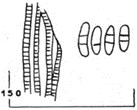


![]()













![]()
![]()




Examples of signs associated with animals
Incidentally, here are a few readings he mentions that illustrate the association of these signs with animals
Single sets
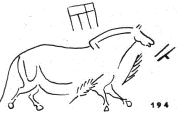
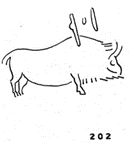






Complex sets

Injured animals and hunting magic
André Leroi-Gourhan also points out that the number of recorded wounded animals is too small (less than 2.5% for the bison, which represents the maximum number of cases) for these representations to be hunting magic. What’s more, all these figures are placed in a particular context, with, for Lascaux: an ox, a horse and a bison, distributed throughout each of the major series (rotunda, nave, felins cave).
He concludes that “the wounded animal is a character who appears sporadically in the compositions and whose role can, to a certain extent, be defined”, but here again, he ends up associating wounds with sexual symbols.
Example of a wounded animal


Conclusion by A. Leroi Gourhan
“Everything seems to indicate that the decorated caves are sanctuaries whose decoration is highly organized and proceeds by repeated compositions, separated by transition zones marked by appropriate signs or animals. For the compositions, the formula that can be glimpsed corresponds to a group of large herbivores, belonging to two species in which the horse practically always figures. One of the two species is numerically dominant. This central group is flanked by complementary animals, most often deer or ibex. Generally abstract representations of man and woman are juxtaposed, or, more generally, of male and female values”.
“While the overall organization and distribution of the animals bear witness to a singularly complex creative thought process, the use of symbolic signs goes far beyond the idea that primitive people could depict, with great artistic mastery, their game caught in traps or succumbing by intention to assegais and boomerangs.
How far can we reconstruct this thought? If we absolutely don’t want to replace the facts with the plot of a novel, what we can say at this point is not considerable”.
He then mentions the theme of fecundity, pointing out that “fecundity and destruction are not incompatible, and a metaphysics of birth and death clearly underlies the whole figurative ensemble. This, too, is so common to all religions that it seems trivial. However, it is a significant achievement to prove the existence, in the Upper Paleolithic, not of hunting magic, but of a genuine metaphysics”.
“Another feature seems to be the highly symbolic nature of the representations. I may not fully agree with Mme Laming-Emperaire when she considers the conventional assembly of these animals, which do not normally live side by side, as the expression of a mythology, but there is certainly some truth in her opinion. The assembly of figures undoubtedly corresponded to an oral context of remarkably fixed form, if we bear in mind that it lasted for several millennia in a geographical space that extended from southern Spain to eastern Europe, since the movable works of eastern Europe reflect the same concerns”.
“The evolution of the signs themselves is no less striking. Their role escapes us in all its detail, and we can only record the curious male-female-bison-horse crossovers that a greater number of examples would perhaps allow us to better define. In any case, the bizarre transmutation of the bison into a woman at Pech-Merle (181 to 183) must be seen as something other than an artist’s game, just as the character of the Three Brothers, synthesizing the three animals (horse, bison and reindeer) that make up the fabric of the surrounding panels, is something other than a sorcerer in disguise. The signs reveal a remarkable conventionalization of symbols and a figurative behavior that could almost be described as pre-ideographic”.
He concludes by saying “that it would be very easy to be tempted by comparisons, to evoke examples drawn from proto-history or from distant and nearby peoples, but two reasons prevented me from doing so. The first is a methodological one: I had to examine the Palaeolithic documents, and them alone, to avoid the risk of coming up with answers as well as questions. The second is common sense: symbolism based on the representation of reproductive organs is unlikely to be the exclusive preserve of the Upper Paleolithic.”
What to make of his research?
In other words, with regard to his argument of method, we’re touching on what I expressed earlier, namely that it is ethically inconceivable for an archaeologist, in relation to his peers, to dare to make comparisons with representations from later periods of time, even if such comparisons were possible.
What a strange way of reasoning, not to compare what are, from a symbolic point of view, eminently comparable, and to draw lessons from them!
This explains why the understanding of these signs has remained at the same level since…
However, we must pay tribute to his work in collecting and classifying signs, which provides a database of signs for comparison with Sumerian proto-ideographic signs.
And even if his hypothesis is that they are male-female signs evoking sexual union and fertility in a context of birth and death – which is a profound error, since it still consists in seeing prehistoric man as nothing more than a simpleton – he has nonetheless perceived with obvious acuity fundamental notions such as the fact that the cave was clearly a sanctuary, with representations arranged in a pre-reflective way to transcribe a metaphysics and, he shares, the mythology of our ancestors of the time, who respected a symbolic writing convention that seems to have remained unchanged over millennia in the European space, which he even qualifies as pre-ideographic for its figurative character.
These are certainly wise and important comments.
If only he had known that these were in fact proto-Cuneiform ideographic characters, he would have abandoned his scruples about comparing this mythology with that of Sumer, and we would have been able to make much more progress since 1958, 1965 – the dates of his essays and revised edition.
The research of Georges Sauvet Suzanne Sauvet and André Wlodarczyk
Source : Essai de sémiologie préhistorique (pour une théorie des premiers signes de l’homme. Bulletin de la société préhistorique française / année 1977 / E&T 47-2 / p.545-558
Introduction
In their introduction, the authors begin by saying that instead of considering Paleolithic signs as representations of objects used by prehistoric hunters (weapons, traps, huts, etc.), as has been the case for almost half a century, it turns out that they are part of a veritable semiological system, with each sign clearly having a signifier and a signified, and the signs being clearly articulated with a syntax of their own.
They then raise the question of the homogeneity of these signs over time, and respond by saying that, contrary to what one might think at first glance, “all the signs of the Western Upper Paleolithic, spread over 20,000 years and millions of square kilometers, belong to the same system of thought“, because in rock representations “continuity is manifest“, attesting to “an astonishing community of thought”, even if of course there are “regional peculiarities” and “stylistic evolution”.
He concludes that “there is nothing to prevent us from assuming that the men of the Upper Palaeolithic drew their conception of the world, their metaphysical and religious aspirations, their myths and all their traditional knowledge from the same sources, and that this spiritual communion found extensions on a ritual or artistic level. The graphic arts in particular will have common characteristics that reveal the thought that inspires them. It is these characteristics that we can hope to discover by bringing together signs that, in the absence of evidence to the contrary, we will assume to belong to a homogeneous whole (possibly divided into synchronic and diachronic subsets)”.
In order to demonstrate that the science of semiology is the key to understanding these signs, they therefore consider it necessary to begin by assembling a significant corpus of signs, a database (focusing on the signs of cave art from the Franco-Cantabrian region, since most of the decorated caves are located within this restricted perimeter), in order to then be able to draw up a typology of basic signs.
After working on a corpus “based on 60 French and Spanish caves, and representing 374 situations in which one or more signs appear”, here is the typology (or list of signs) they came up with:
Typology of parietal signs
Assuming that, despite the great variability of signs, it is possible to identify a basic geometric form, the typology they have obtained highlights 12 major categories of signs (which the authors call keys).
Description of their painting (quote): Table of signs whose role is to evoke the constancy of Upper Paleolithic human behavior with regard to early ideographic writing, both in graphic relationships with art and in collective or individual activities, and in perceptions and uses of symbols.
Point-down (a) and point-up (b) triangles.


III. Typical quadrilaterals (a), with appendages (b) and open (c) [“grids” or “combs”].
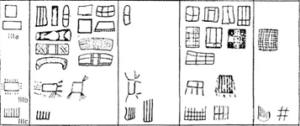



VII. Single-axis (a) and multi-axis (b) arrows

VIII. barbed and “branch” signs


![]()

XII. Single-line (a) and multiple-line (b) punctuations; point clouds (c).

N.B. – The signs listed here are merely examples to illustrate the wide variety of shapes.
In this list of signs, the authors note that the last two keys (rods and dots), unlike the first ten which are circumscribed in space, are “real elementary particles capable of entering in unlimited numbers into clusters of any shape”, which undoubtedly gives them a special function in the system.
They also consider their classification to be perfectible, citing as examples the classification of crescent-shaped signs as quadrangular, multiple-axis arrows (Vllb) as arrows even though they resemble “pseudotectiforms” (VIb), and the difficulty of distinguishing the difference between quadrangular signs with outgrowths (IV) and claviforms (V).
The authors also note that while some keys are universal, others, such as tectiforms, are regional in character.
They say they haven’t taken the hand signals into consideration, hesitating to “consider them as real signals, even though they have very remarkable relationships with some of them”.
Additions to the basic form
Starting with quadrangular signs, they also developed elementary graphic forms (crosshatching, scalariform stripes, cut-outs) to add to the basic quadrangular shape.
Here is their table highlighting these additions
Table II. – case of Franco-Cantabrian rectangles with additions To the basic shape
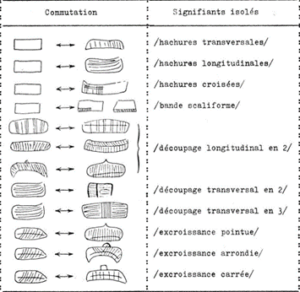
Association of multiple additions to the basic form
After identifying the nature of the possible additions, they realize that these multiple additions can associate with each other and with the basic form.
They note that these additions “alone make it possible to describe almost all the signs in this family (the Franco-Cantabrian quadrilaterals), and that no more than three or four elements were ever used simultaneously.
Here is their table with examples:
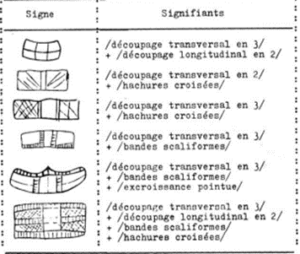
Without being able to answer the question of whether these additions are themselves signs, they conclude “that the principle of sign articulation was known”.
This observation is based on the specific analysis of quadrilaterals of Perigordian and Cantabrian origin, which show extremely clear specific characteristics, and the authors believe that they may be “witnessing the first manifestations of a cultural divergence. It is conceivable that two populations maintained in relative isolation could have developed highly complex systems based on a common basic theme”.
Combining elementary signs to create complex signs
Having noticed that a basic sign (a rectangle) could be associated with additions, as in the specific case of rectangles, the authors then identify that the different keys can be associated with each other by three distinct types of association:
Integration, superimposition and juxtaposition, generating complex signs, i.e. signs associated with each other
Here are some examples
Table IV. – Processes for obtaining complex signs
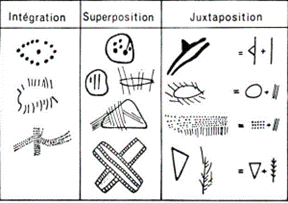
They then put forward the hypothesis that different combinations must produce different meanings.
It’s particularly interesting to note that the authors also point out that “ideographic scripts have also made extensive use of such sign assemblies, which expand the system without weighing it down.
And he cites the fact that these assembly processes (juxtaposition, superimposition) exist in Chinese writing, and have even been integrated into Mayan glyphs.
He concludes that “these examples simply illustrate the principle of economy inherent in any semiological system“, and that “structurally speaking, these different modes of combination, which in at least one case go as far as true articulation, attest to the fact that the system’s users knew how to establish logical relationships between abstract concepts. This faculty, which could be described as an aptitude for second-degree abstraction, should come as no surprise in prehistoric man, since, as Lévi-Strauss has shown with regard to totemic classifications, it manifests itself at all stages of primitive thought”.
The results of their research on the reality of a sintax
Major means of interpretation
The authors identify two major elements likely to attest to a syntax [syntax as “the set of laws that fix the relationships that signs have with each other”] in order to deliver a message:
- their relationship with animals
- the relationship between signs
Relationships with animals
The authors believe that animal representations and signs are likely to be part of a single semiological system.
The reasons given were that :
- 60% of parietal signs are directly related to animals
- Certain signs and animals are superimposed on a panel totally isolated from the rest of the representation (figure 3) or when the same theme is repeated several times [animal accompanied by punctuation 18 times observed; association of the mammoth with the tectiforme (several cases at Font de Graume and Bernifal)].
Fig. 3. “ Horse with 14 claviforms” from the “cave of the three brothers” (Ariège), after H. Breuil, located several meters above sea level.
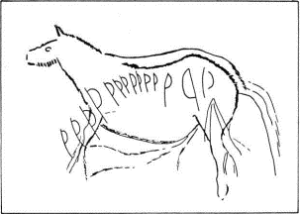
The authors note that the two systems of representation seem to interpenetrate and influence each other.
They came to believe that the signs could be schematic simplifications of the initial animal forms, and produced the following examples to illustrate this (in particular, the schematic representation of the horse, which looks as if it could become a claviform)
Fig. 4 – Associations of signs and schematic animals
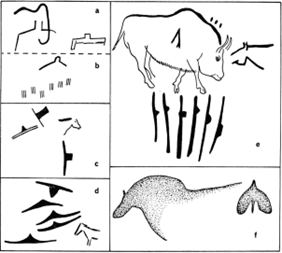
A -Black signs and red mammoth silhouette; b -Black rods and red feline (?) occipito-frontal line; c, d, e, f -Schematic equine claviform and protome. – a, b -Cougnac (Lot); c, d -La Pasiega (Santander); e -Pindal (Asturias); f -Le Portel (Ariège).
Evidencing syntax through relations between signs
The authors believe that although animals are part of the semiological system, and even the topographical layout, when they are associated with signs, the latter also have a meaning of their own.
“A final methodological problem is raised by the frequent proximity of signs and animals. One might even think that they are “indecipherable” without each other, and that a study of signs as an autonomous semiological system would therefore be doomed to failure. However, the existence of “sign panels” in which no animal appears makes this objection implausible, and in what follows we’ll admit that signs have a meaning of their own, while reserving the right to study the relationship between the two types of expression”.
To ensure that a system is semiological, it is necessary to identify compatibilities and incompatibilities between signs.
The authors then set out to find these rules of compatibility between signs.
They found that some of the twelve keys are used more frequently than others, with 9 dominant keys, that nearly two out of three messages are made up of a single key, that the number of complex signs associating several keys decreases with the number of keys used, reaching a maximum of 4 associations, and that some keys tend to be isolated (quadrilaterals, punctuations, tectiforms), while others preferentially enter into associations (claviforms, ovals, rods).
Analysis of the combinations of the 9 major keys shows them to obey restrictive rules, as some combinations are repeated, others do not exist, and of all the mathematically possible combinations only a very small number are observed (13 triads out of 84 possible and 8 tetrads out of 126). What’s more, the same sign incompatibilities are found in both diads (2 associated signs) and triads (3 associated signs), which systematically include dots or rods, reducing the use of other signs and giving them a special role.
The authors conclude that “far from being formed at random, as we might have thought, groups of signs are governed by laws, and that a few simple rules are enough to account for existing compositions, while explaining why they are so few in number among the multitude of theoretically possible formulas”.
This, of course, responds to a semiological system.
What’s particularly interesting here is that the researchers eventually identify all observable compatibilities – incompatibilities and summarize them using the following summary diagram:
Fig. 2 – Compatibility of keys in binary association
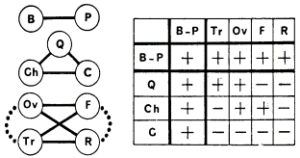
В = rod; P = punctuation; Ch = chevron; С = claviform; Q = quadrilateral; R = branch; F = arrow; Tr = triangle; Ov = oval.
How do you read this picture?
Well, for example, if we take the CH sign, chevrons, in the third line, it appears from this table that the chevron can be associated with rods or dots (+ sign at the intersection of CH with the B-P column), it can be associated with an oval or arrow (+ sign at the intersection of CH with the Ov or F columns); on the other hand, it cannot be associated with a triangle or branch (- sign at the intersection of CH with the Tr or R columns).
What does this synthesis show us?
That there are three groups of signs:
- Points and sticks that can be combined with all the others
- Quadrilateral-Chevron-Claviform signs in combination
- The signs Triangle-Oval-Branch-Arrow, which are associated with each other, except for the oval, which is not associated with the triangle, and the arrow, which is not associated with the branch.
As for associations between signs in groups 2 & 3 :
- The quadrilateral (2) is associated with the oval (3) and triangle (3), but not with the arrow (3) and branch (3).
- The chevron (2) is associated with the oval (3) and arrow (3), but not with the triangle (3) and branch (3).
- The claviform (2) is only associated with rods and dots [1] and therefore not with triangle (3), oval (3), arrow (3) and branch (3).
Complementary means of interpretation
The authors also mention a number of complementary aspects to be taken into account:
- The symbolic context of the cave
- Integrating the sign with the surrounding rock
- Topography
- Execution technique
The context of the cave :
According to the authors, the cave “has its own symbolic value that influences the content of the message, no doubt in the manner of a connotation. If it doesn’t impose, it suggests“.
Integrating the sign with the surrounding rock
Animal figures and signs are often integrated with the characteristics of the rock support in which they are made (concavities, bumps, fissures, cupules, fractures) to “evoke a belly, a gibbosity, a horn or an eye”.
Topography
The authors consider that ‘the location of the figures in the cave (at the beginning, at the end, in given places) is undoubtedly an important significant element’, but does not have a syntactic value in itself.
Execution technique
Since painting and engraving are used at the same time on some engravings, which attests that the choice to use one or the other was not a material contingency, but had a meaning (the “Horned God” of “The Three Brothers”, the only painting in the Sanctuary, reigns over the multitude of engraved animals crowding at his feet; the single engraved rectangle of Las Chimeneas contrasts with the black quadrilaterals of the same cave; the single red tectiforme of Bernifal contrasts with the dozen others engraved).
Similarly, the use of color is predominantly red (around 75%), with red and black signs deliberately combined in 10% of cases, probably attesting to the profound meaning attached to the Red-Black opposition.
Their opinion on the search for meaning through comparative ethnographic analysis with more recent practices
In their view, using this type of comparison, with civilizations using a system similar to that of more recent civilizations (“advocated by Reinach as early as 1903 and used by Cartailhac and Breuil in 1906″), “provided invaluable results in its time, since it enabled us to recognize that the works of art of primitive peoples still represent ‘a serious significance in relation to metaphysical and religious conceptions'”.
They believe, however, that the method is dangerous, and that ethnography should limit itself to broader issues (highlighting constants in human behavior (the relationship of graphic arts to other collective or individual activities, the perception and use of symbols, etc.), in other words, not seeking to explain one system by another.
To illustrate this, they take the example of ideographic writing.
They add that we might be tempted to compare ideographic scripts with parietal signs because they have the same type of structure (integration, juxtaposition and superposition), or because some signs resemble each other (triangular sign close to the vulva and meaning woman in Sumerian and Hittite; branch ideogram signs identical to rock art signs) except that, from their point of view, ideograms that can be compared with rock art signs have meanings that are too diverse… and propose the following table as an example:
Table VII: Morphological comparison between Paleolithic signs and ideograms
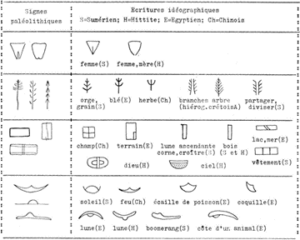
And we shouldn’t “forget that ideographic writings very often make use of symbolic transfers of meaning (synecdoche, metonymy, metaphor, etc.), and that the same is probably true of prehistoric signs. If, by some extraordinary chance, we were to discover their figurative origins, we’d still be a long way from being able to deduce the meanings to which they refer, which may, moreover, have drifted over time”.
As a result, they say, “this route is nothing but a dead end!
They consider it unwise to venture further into the field of semantics unless all elements are taken into account, i.e., in addition to the main elements such as associations with animals and relationships between signs, secondary elements such as context (the cavern symbol), support [integration of the sign with the surrounding rock (concavity, bump, fissure…)], topography and the technique used.)], the topography, the technique used, for “all of these contribute indissolubly to its meaning, and it is only at the price of an enormous work of synthesis that we can hope one day to dispel what Mircea Eliade calls “the semantic opacity of prehistoric documents”.
Returning to their work, they conclude by saying that they have “highlighted the semiological character of Paleolithic parietal signs, showing that they possess all the properties of a conventional communication system”, and were able to partly characterize the “code” governing the constitution of units and their relationships.
As a result, “we have been able to reject the previously accepted hypothesis that the figures were randomly accumulated along the walls. On the contrary, we were able to show that it was a highly structured system”.
Note
Every time I reread the conclusion of their work, I can’t help thinking: What a pity, my God, what a pity, because they were so close to the goal!
The solution was right there in front of them, but they didn’t explore it, so they didn’t see it.
But before we look at why this conclusion is unfortunately largely wrong, let’s take a brief look at what the work of Denis Vialou and Genevieve von Petzinger has contributed.
Denis Vialou’s work [1]
In 1981, Denis Vialou proposed a typological classification of Magdalenian Ariège parietal signs based on four groups: punctuated signs, linear signs and simple derivatives, and constructed signs subdivided into constant-structure signs and complex signs. The latter are site-specific.
Themes in Paleolithic cave art. Patrick Paillet
Denis Vialou argues that Magdalenian parietal signs became symbolic forms comparable to pictograms in the cradle of various scripts. By studying cave art and coming into contact with the non-figurative signs that make it up, Vialou discovers a codified, standardized mode of expression. For him, as for André Leroi-Gourhan and María del Pilar Casado López, the signs that we are attempting to associate with a form of pre-writing are part of a broad formal diversity that has been classified into families, and whose codification becomes clearer at the dawn of the Magdalenian period in the Franco-Iberian region.
https://www.diphonique.com/-propos2-cj6i
Note:
You can see that, of all of them, Mr. Vialou was very close to the truth, distancing himself from his colleagues and seeing this writing as a form of proto-writing.
The research of Geneviève von Petzinger
What’s particularly interesting about the work of this Victoria University archaeology student working under the tutelage of Professor April Nowell is that she has identified 26 signs common to 146 French prehistoric sites, corresponding to a period from -35,000 to -10,000 years ago, and above all, I would say, that she has also identified them in many other areas of worldwide observation, which attests to the fact that this language had a worldwide dimension and not just in the Franco-Cantabrian area, in addition to having been in use over a very long period of time.
Here is a summary map of this distribution:
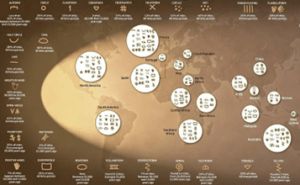
FOOTNOTES AND REFERENCES
[1] Denis Vialou is a prehistorian and specialist in prehistoric art. He teaches at the Institut de Paléontologie humaine, and heads the Laboratoire de Préhistoire at the Muséum National d’Histoire naturelle.
BIBLIOGRAPHY
Proto-sumerian :
CNIL. Full list of proto-cuneiform signs
& Falkenstein, A. (1936). Archaische Texte aus Uruk. https://www.cdli.ox.ac.uk/wiki/doku.php?id=late_uruk_period :
Sumerian :
A.Halloran, J. [1999]. Sumerian Lexicon 3.0.
Heroglyphic :
Faulkner. [réed .2017]. Concise dictionary of Middle Egyptian.
Hiero (hierogl.ch) (Hiero – Pierre Besson)
Demotic :
Hieroglyphic Hittite :
Mnamon / Antiche scritture del Mediterraneo Guida critica alle risorse elettroniche / Luvio geroglifico – 1300 a.C. (ca.) – 600 a.C.
https://mnamon.sns.it/index.php?page=Scrittura&id=46
https://www.hethport.uni-wuerzburg.de/luwglyph/Signlist_2012.pdf
Archaeology :
Leroi-Gourhan, A. (1958). Le symbolisme des grands signes dans l’art pariétal paléolithique. Bulletin de la Société préhistorique française Année 55-7-8 pp. 384-398.
G.& S Sauvet et André Wlodarczyk (1977) : Essai de sémiologie préhistorique (pour une théorie des premiers signes de l’homme). Bulletin de la société préhistorique française / année 1977 / E&T 47-2 / p.545-558
Science of Symbols :
Chevalier-Gheebrant [2005]. Dictionnaire des Symboles. Paris: Robert Laffont.
Mythologies :
Guirand, J. [1996]. Mythes et Mythologie. Paris ; Larousse
Link between Chaldean and the Catholic religion :
A.Hislop. [s .d.]. Les deux Babylones.
REMINDER OF THE LINK BETWEEN THIS ARTICLE AND THE ENTIRE LITERARY SERIES “THE TRUE HISTORY OF MANKIND’S RELIGIONS”.
This article is an excerpt from the book also available on this site:
Volume 2 Book 2 Deciphering the language of the caves
You can also find this book here :
Already published books
To find out why this book is part of the literary series The True Stories of Mankind’s Religions, go to page :
Introduction / Structure and Content
COPYRIGHT REMINDER
As a reminder, please respect copyright, as this book has been registered.
©YVAR BREGEANT, 2023 Tous droits réservés
The French Intellectual Property Code prohibits copies or reproductions for collective use.
Any representation or reproduction in whole or in part by any process whatsoever without the consent of the author or his successors is unlawful and constitutes an infringement punishable by articles L335-2 et seq. of the French Intellectual Property Code.
See the explanation at the top of this section. the author’s preliminary note on his book availability policy :
